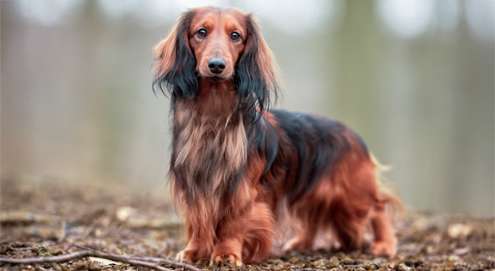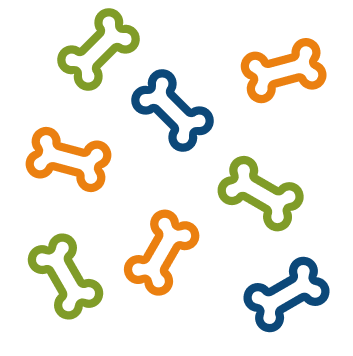Dachshund
The Dachshund, is an intelligent, lively and brave dog with a distinctive elongated body and short legs. Originally bred in Germany for hunting badgers and other burrowing animals, it is known for its courage, perseverance and keen sense of smell. Though small in stature, the Dachshund has a big personality and knows exactly what it wants. With its compact build, alert posture and proud expression, it exudes confidence and determination. The Dachshund is loyal to its family, often forms a close bond with one person, and loves attention and involvement. Its energetic and sometimes wilful nature calls for consistent yet loving training.

Characteristics
Character profile
Origin of the Dachshund
The Dachshund, also known as the Teckel, originated in Germany, where it was bred in the Middle Ages for underground hunting. The name “Dachshund” literally means “badger dog”. Thanks to its compact body and sharp sense of smell, the Dachshund was extremely well-suited for driving out badgers, foxes and rabbits from their dens. In the 19th century, the breed was further developed into the three coat types we know today: smooth-haired, wire-haired and long-haired. Each type had its own hunting specialisation.
Character of the Dachshund
The Dachshund is lively, brave and sometimes stubborn. Despite its small size, it has great self-confidence and is often vigilant and alert. It is loyal to its family and can be affectionate, but also has an independent side. Dachshunds are intelligent, but can be headstrong, which makes consistent and patient training important. They are playful and curious, and enjoy being active, especially with scent work or digging. The Dachshund is often watchful and likes to bark when it hears something suspicious.
All about the Dachshund
What does the Dachshund look like?
The Dachshund has a long, muscular body with short, sturdy legs. The head is elongated with an alert expression and dark eyes. Depending on the coat type (smooth, wire or long), the coat varies in texture, but in all cases it fits closely to the body. Colours include red, brindle, black with tan markings and chocolate brown.
How much exercise does a Dachshund need?
Although small, the Dachshund has an energetic nature and loves to stay active. A minimum of one hour of walking per day, combined with playtime or mental challenges (like scent games), is ideal. Dachshunds enjoy digging and tracking, so activities that engage their sense of smell are favourites. Be cautious with jumping or stair-climbing, as their sensitive backs require avoiding overexertion.
What kind of grooming does a Dachshund need?
Grooming depends on the coat type:
- Smooth-haired: weekly brushing is sufficient.
- Long-haired: regular brushing to prevent tangles, especially behind the ears and around the legs.
- Wire-haired: regular brushing and hand-stripping 2–3 times a year to remove dead hairs.
It is also important to keep the ears clean, trim the nails regularly and care for the teeth by brushing frequently. Regular check-ups with the vet contribute to the overall health of the dog.
What are the most common health issues in Dachshunds?
The Dachshund is a brave and lively breed, but unfortunately also prone to several hereditary conditions. Due to its long back and short legs, intervertebral disc disease (IVDD) occurs relatively often. This condition damages a spinal disc, which can lead to pain, mobility issues or even paralysis of the hindquarters. Excess weight and frequent stair-climbing increase this risk, so prevention is key.
Dachshunds are also predisposed to epilepsy. This can manifest as seizures where the dog stiffens, loses consciousness or has uncontrolled movements. In some cases, Lafora disease occurs, an inherited form of myoclonic epilepsy that can develop at a young age. This condition causes sudden muscle spasms, often triggered by light or sound.
Another condition that Dachshunds are susceptible to is mitral valve disease. This is a progressive heart condition in which a heart valve no longer closes properly, leading to shortness of breath, fatigue and eventually heart failure.
Due to their build, Dachshunds can also suffer from chondrodysplasia, a cartilage disorder that results in short legs and sometimes deformed limbs. Other potential conditions include hip dysplasia, portosystemic shunt (a liver disorder), and various spinal abnormalities. Early detection, regular veterinary check-ups and avoiding overexertion are essential to ensure a healthy and active life for the Dachshund.
Which breeds are similar to the Dachshund?
While the Dachshund is a unique breed, a few other breeds share similarities in size, temperament or appearance:
- Jack Russell Terrier: energetic, headstrong and compact; similar in behaviour
- Cairn Terrier: alert and independent small dog, also originally bred for hunting
- Miniature Pinscher: small, brave and spirited, though with a different build
What should I consider when getting a Dachshund?
When considering a Dachshund, it is important to find a reputable breeder who focuses on health and temperament. Ask about health tests, especially for back and eye problems. Socialisation is also key: a well-socialised puppy is raised in a home environment and is accustomed to people and household sounds. Choose the coat type that best matches your lifestyle in terms of grooming needs.
What kind of owner is a Dachshund suitable for?
The Dachshund is best suited to an owner who can handle an independent and sometimes wilful character. It loves companionship and being involved in daily life, but also needs clear boundaries.
The Dachshund is suitable for an owner who:
- Has experience with dogs or is willing to research thoroughly
- Enjoys walking and active play
- Is consistent and patient in training
- Is mindful of the risk of back problems
- Can provide time and care for mental stimulation and physical activity
- Appreciates a dog with personality and humour
All in all, the Dachshund is an excellent choice for someone looking for a smart, quirky and loyal dog with character. It suits people who enjoy a challenge, are active with their dog, and understand the importance of training and health care.
Is the Dachshund suitable for first-time or experienced owners?
Due to its stubborn and independent nature, the Dachshund is less suited to first-time owners without preparation. With proper guidance and clear rules, however, it can still be a great companion for a first-time dog owner, provided they commit time and effort to training and care.
The Dachshund is suitable for experienced dog owners or motivated beginners who are willing to learn about the breed. Its brave and sometimes headstrong character requires patience and clarity, but in a loving and consistent environment, it truly thrives.



